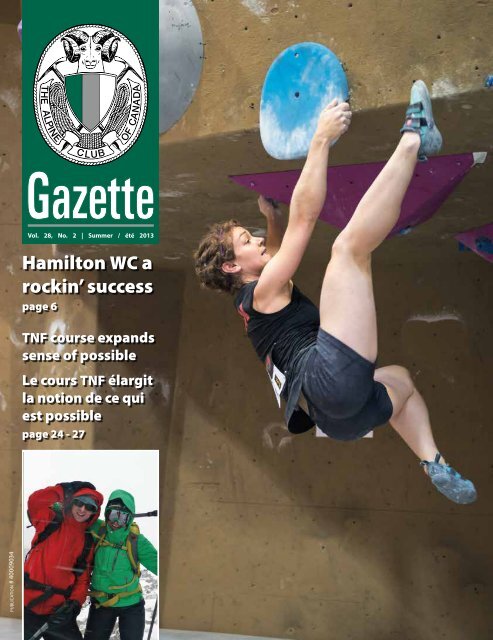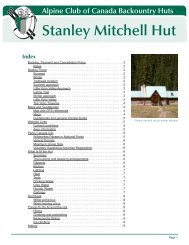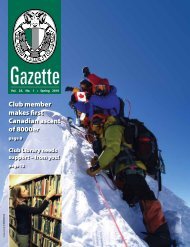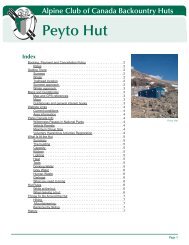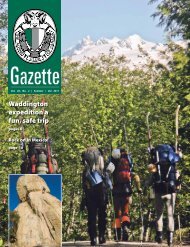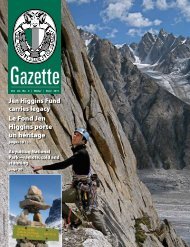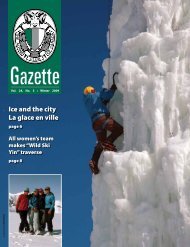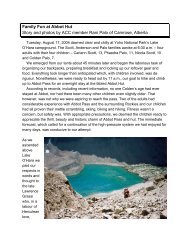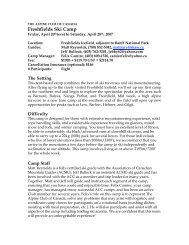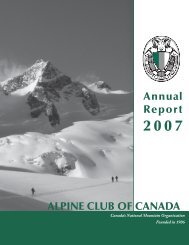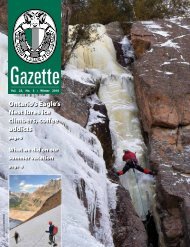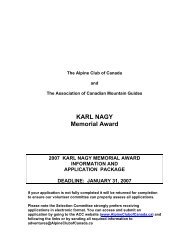Summer 2013 Gazette - The Alpine Club of Canada
Summer 2013 Gazette - The Alpine Club of Canada
Summer 2013 Gazette - The Alpine Club of Canada
You also want an ePaper? Increase the reach of your titles
YUMPU automatically turns print PDFs into web optimized ePapers that Google loves.
THIS SEASONA CHANCE TO BE IN YOURELEMENTIS NOW AVAILABLE AT MECMEC.CA/VERTICALChristian LamontagneEQUIP YOURSELF FOR THE VERTICAL WORLDSandstone hollows, granite boulders,or polished limestone sport routes.Get it at MEC.Shop MEC appmec.ca/iPhone
<strong>2013</strong> Canadian <strong>Alpine</strong> Journal on sale nowLynn follows 2012 Mountain Guides Ball PatronFerdl Taxbock up the Northeast Face route on HaLing, high above Canmore. photo by Ferdl TaxbockShort ropeby Lynn MartelPutting together each issue <strong>of</strong> the<strong>Gazette</strong> is like fitting togetherthe pieces <strong>of</strong> a puzzle—for me,as editor, and also for Suzan Chamney,who designs each page so creatively andskillfully, one by one. But unlike a jigsawpuzzle, whose pieces are all contained ina box to be dumped out onto a tabletop,when I begin working on each issueabout six weeks before its date with theprinter, I don’t know what all the pieceswill look like. Throughout the year, andespecially during those weeks, emailsland in my inbox with stories and photos,many <strong>of</strong> which have been pitched to mebeforehand, but there are always surprises.Outside those six weeks, three timesa year, I do keep the <strong>Gazette</strong> on my radarwith an eye to what might make a goodstory for a future issue. For this issue,a little more planning than usual wasrequired.First, back in January, Toby Harper,who is currently on parental leave fromhis position as <strong>Alpine</strong> <strong>Club</strong> <strong>of</strong> <strong>Canada</strong>Programs Director, brought my attentionto the World Cup Bouldering competitionscheduled for June in Hamilton,Ontario. As the second WC climbingevent to be hosted by <strong>Canada</strong>—and theACC, the governing body for competitiveclimbing in this country—this wouldbe an important story. Unlike <strong>Canada</strong>’sfirst WC, however, which took place inCanmore, I would not be there to writeabout the event. On top <strong>of</strong> that, theHamilton WC would take place just days<strong>The</strong> arctic sun had crossed all the cardinalpoints on the horizonand was hidden behind thePenny Icecap to the north.Streamers <strong>of</strong> fog and rainslipped across the peaks as thefirst hint <strong>of</strong> darkness started to settleover the northern landscape. A windfrom the southwest was blowing hard.I ducked into a fissure on the summitplateau and prepared for the descentby pulling the smallest cam <strong>of</strong>f myharness and setting it into a perfectbottleneck crack. This blue Alien—atalisman fixed to my harness for thepast three months, and a lost partner’sfavourite cam—was a guardian thatprotected me, and now it’s a gift tothe mountain. I said a prayer, and thenturned into the wind and rain, followingmy partners into the darkness.Joshua LavigneRead the rest <strong>of</strong> Joshua Lavigne's story Sensory Overload inthe <strong>2013</strong> Canadian <strong>Alpine</strong> Journal. $29 from our online store.Add a subscription for the 2014 CAJ to your membershipfor $22 including shipping (in <strong>Canada</strong>), lower still if youalso have the Huts Option on your membership!www.alpineclub<strong>of</strong>canada.ca/store/before this <strong>Gazette</strong> would be scheduledfor the printer’s. <strong>The</strong> deadline would betight.But, as ACC Executive DirectorLawrence White writes in his OpenAir column on page 30, that’s where theimpressive cooperation <strong>of</strong> <strong>Club</strong> membersliving thousands <strong>of</strong> kilometres apart cameinto play. In January, Toby Harper put inme in contact with competition organizer,Luigi Montilla, who connected mewith some Ontario photographers whoplanned to shoot the event. I asked if theywould be willing to donate some <strong>of</strong> theirimages on a very tight deadline—a tallorder, since sifting through hundreds <strong>of</strong>images shot over two days with 69 athletescompeting would be a considerableamount <strong>of</strong> work.I’m thrilled to say, with great thanksand deep appreciation to talentedphotographers Miguel Jette and DavidKawai, and also Calgary’s Pam Eveleigh,whose image <strong>of</strong> her son, Marc, a YouthNational Climbing Team member,appeared on the Spring 2011 cover <strong>of</strong>the <strong>Gazette</strong>, this issue is loaded withfabulous WC images, all <strong>of</strong> which arrivedon deadline! As is true with all amateurlevel sports, particularly those in theirearly years <strong>of</strong> development, the countlessvolunteer hours <strong>of</strong> family members andfriends <strong>of</strong> the athletes are vital to thesuccessful planning and execution <strong>of</strong> thecompetitions essential to growing thatsport.In addition to the photographers’ generouslydonated images, these pages als<strong>of</strong>eature stories by members from Ontarioto Edmonton, written about adventuresexperienced on mountains from Tanzaniato New Zealand to the king <strong>of</strong> theCanadian Rockies, Mount Robson.Enjoy the fully-assembled puzzle!4 <strong>Alpine</strong> <strong>Club</strong> <strong>of</strong> <strong>Canada</strong> <strong>Gazette</strong> <strong>Summer</strong> <strong>2013</strong>
Member initiates Gmoser Film Preservation Projectby Chic ScottBetween 1957 and 1968, HansGmoser produced ten films <strong>of</strong>mountain adventure which hethen toured across North America. Many<strong>of</strong> us have wonderful memories <strong>of</strong> thosepresentations; Hans at the microphonedressed in his Austrian sweater, gloriousski and climbing images on the screen,and beautiful classical music in the air.For many <strong>of</strong> us, those evenings were thebeginning <strong>of</strong> our long love affairs withthe mountains.Soon it will be possible to relive thosemagic experiences. Chic Scott and MargSaul, in partnership with the WhyteMuseum <strong>of</strong> the Canadian Rockies,and with the assistance <strong>of</strong> pr<strong>of</strong>essionalQuick draws<strong>Canada</strong> to host Youth WorldsClimbing Escalade <strong>Canada</strong>selected the Youth National ClimbingTeam members who will represent<strong>Canada</strong> at the World Youth ClimbingChampionships, taking place inSaanich, Vancouver Island, August15 thru 19. <strong>The</strong> team’s Head Coach isChris Neve, supported by AssistantCoach Ron Gosselin and AssistantCoaches Dūng Nguyen, Sean McColl,Stacey Weldon and Denis Mimeault.For a complete list <strong>of</strong> team members,visit www.alpineclub<strong>of</strong>canada.ca/cecAnd congratulations to MarcEveleigh, current Pan-American YouthBouldering champion!Canadians reach new skimo heightsRevelstoke, B.C.’s Melanie Berniercapped a stellar season by teaming upwith American Janelle Smiley to takefourth place in the prestigious andgruelling Pierra Menta ski mountaineeringteam race which took place inFrance in March—the best ever rankingfor a North American team in therace’s 27-year history. Fellow Canadianskimo team members, AndrewMcNab and Reiner Thoni placed 15thin the men’s category, a top result forNorth American men. Read more atgenuineguidegear.com .filmmaker Will Schmidt, are digitizingand reassembling these films, just as theywere 50 years ago.Hans Gmoser presented his filmseach year at more than 50 different venuesall across North America. While the filmrolled on the screen and a soundtrack<strong>of</strong> classical music played independently,Hans would personally narrate thestory. All three elements came togetherin a remarkably seamless and beautifulproduction. In his films, Hans tookus ski touring at Rogers Pass and theLittle Yoho Valley. Together we exploredthe icefields along the ContinentalDivide and climbed the east ridge <strong>of</strong>Mount Logan in the Yukon and MountMcKinley in Alaska. We rock climbedhigh on Yamnuska, Mount Louis andCastle Mountain. And, <strong>of</strong> course, we werethere in the Bugaboos in 1965 and ’66 forthe first years <strong>of</strong> heli-skiing.All ten films are now safely storedat the Whyte Museum in Banff, as areseven <strong>of</strong> the original scripts. <strong>The</strong> filmsmust first be transferred to a high definitiondigital format, a major expense initself. Since Hans is no longer with us tonarrate the script, we have come up witha novel solution—Michael Hintringer,Hans’ nephew who lives in <strong>Canada</strong> butwas born and raised in the same Austriantown where Hans grew up, and whoseaccent is almost identical to his uncle’s,has volunteered to narrate the scripts.For the films, to which original scripts donot exist, we are writing a commentaryexplaining the action, which will be narratedby Chic Scott. All <strong>of</strong> this requiresmany hours in a sound recording studio.Finally, music must be integratedinto the show. Since much <strong>of</strong> the musicthat Hans used in his presentations (andwhich still exists on tapes in the museum)is under copyright and the original performersare difficult to identify, it willbe necessary to purchase the rights tosuitable music.In addition, it is our goal to interviewabout 15 individuals who appeared inthese films, then to create additional“chapters” using these interviews, archivalphotos and narration to explain the storybehind each film.It is all a very big job, and WillSchmidt, with 35 years’ experienceChic Scott is leading a project to digitize tenadventure films Hans Gmoser produced in the1950s and ’60s. photo Gmoser collectionproducing and directing films, has beenengaged to guide us through this complexprocess.Our budget is $106,000. To date, wehave raised more than $90,000, and feelconfident that we can raise the remainder.Work has begun; we have transferred thefilms to HD and recorded the narrationfor all ten films. We have begun insertingthe classical music soundtrack.For a $500 donation, you too cansupport this project and help make Hans’remarkable films available for viewing.For five years, these films will be availablefor home personal viewing only,and will not be commercially available.For this donation you will receive a tenDVD Collectors’ Edition set PLUS a$400 income tax receipt from the WhyteMuseum <strong>of</strong> the Canadian Rockies.To learn more about this project andto view a short <strong>of</strong> highlights clip fromHans’ films visitwww.whyte.org/archives/projects .For more information, please contactChic Scott at chic_scott@hotmail.com .facebook.com/alpineclub<strong>of</strong>canadatwitter.com/alpineclubcan<strong>Club</strong> alpin du <strong>Canada</strong> <strong>Gazette</strong> été <strong>2013</strong> 5
Hamilton WC a rockin’ success<strong>Canada</strong> proudly hosted its second Bouldering World Cup competition atGravity Climbing Gym in Hamilton, Ontario over the weekend <strong>of</strong> June 1and 2, <strong>2013</strong>.<strong>The</strong> sixth <strong>of</strong> eight WC Bouldering competitions for the <strong>2013</strong> season wrapped upwith Austrian power couple Anna Stöhr and Killian Fischhuber taking home gold,with top-ranked Vancouver climber Sean McColl, who won his first IFSC WorldCup Bouldering competition in Slovenia in May, finishing sixth.Sixty nine <strong>of</strong> the world’s top competitive climbers descended on Hamiltonfrom 14 countries, including Mexico, the US, Russia, Italy, Japan, Great Britain andFrance. Twenty Canadians, including 12 women and eight men competed in qualifyingrounds which took place on the Saturday, with the nail-biting semi-finalsand finals thrilling the crowd on day two.For full results, visit www.ifsc-climbing.org .Well doneTeam <strong>Canada</strong>!World Cup Bouldering repeat champion Anna Stöhr, fromAustria, unleashes her winning power. photo by David Kawai http://kawaiphoto.coIn her final year as a youth competitor, Banff’s Elise Sethnaholds the female dyno record for <strong>Canada</strong>. photo by Miguel Jette/Bonuel PhotographyCanadian Bouldering Champion Sean McColl revs up the crowd—and the paparazzi.photo by David Kawai http://kawaiphoto.coToronto’s Ayo Supejo wowed the WC crowd and also impressed CBC Radiolisteners prior to the event. photo by Miguel Jette/Bonuel PhotographyMontreal’s Sebastien Lazure is, at any given moment, <strong>Canada</strong>’s best malecompetitive climber. photo by Miguel Jette/Bonuel Photography6 <strong>Alpine</strong> <strong>Club</strong> <strong>of</strong> <strong>Canada</strong> <strong>Gazette</strong> <strong>Summer</strong> <strong>2013</strong>
Stacey Weldon : pr<strong>of</strong>ilpar Lynn MartelQuelle fut votre première expérienced’escalade ?À part grimper aux arbres ? Ce futlors d’un cours de gymnastique. Je devaisavoir huit ou neuf ans. Dans le sous-solhumide de l’Université de Calgary, il ya un petit corridor où l’on a mis sur lesmurs des deux par quatre recouverts depapier sablé et des formes découpéesdans du contreplaqué. C’est là que j’aidécouvert qu’il était bien plus amusantd’escalader les murs que de faire de lagymnastique. Mais ce n’est que quelquesannées plus tard, lorsque mon frère ainé,Chris, a joint l’équipe junior du Centred’escalade de Calgary que j’ai réellementcommencé à faire de l’escalade. J’avaispris l’habitude d’accompagner ma mère,qui allait chercher Chris au gym aprèsl’entraînement de soccer, et là je medépêchais d’aller m’amuser sur le vieuxmur d’escalade.Qu’est-ce qui vous a donné le goût depratiquer ce sport régulièrement ?Je ne me souviens pas d’un momentparticulier où j’ai réalisé que l’escaladeétait pour moi, mais j’ai toujours senti queje ne pourrais m’en passer. Bien sûr, dansmon enfance, le fait d’y exceller autantà l’intérieur qu’à l’extérieur a certainementalimenté mon désir de continuer.Mes trois frères et soeurs font partie del’équipe nationale. Ma famille a doncjoué un rôle important dans mon désirde continuer à pratiquer ce sport. Au fildes ans, l’escalade est devenue et demeureencore le sport de la famille Weldon.Comment s’est passée votre premièrecompétition ? Et comment vousêtes-vous sentie lors de celle-ci ?Je me rappelle de ma premièrecompétition à l’échelle nationale. C’était àNanaimo (sur l’Île de Vancouver). J’ai misle pied sur un ancrage et j’ai été disqualifiée.J’ai pleuré.Et pourquoi avez-vous continué àfaire de la compétition ?Je pense que c’est l’atmosphère quirègne aux compétitions qui m’y ramènechaque année. Elles rassemblent unecommunauté de gens vraiment exceptionnels.De plus, j’aime le sentimentque me procure la compétition, l’impressionde me retrouver dans une zone trèsspéciale. Dans la vie, on arrive rarementà se concentrer sur le moment présent,sur le « ici et maintenant », mais lors descompétitions j’y arrive très facilement.C’est un sentiment auquel on devientaccro.Quelle est l’expérience la plus extraordinaireque vous ayez vécue encompétition ?C’est sans doute la Coupe mondialede bloc de Canmore de 2011. Le problèmefinal de qualification comprenait un mouvementde balancement sur une dalle quidemandait un long jeté, sans les mains,où l’on devait se rattraper sur un petitappui. J’ai essayé encore et encore, maisje n’y arrivais pas. Il restait peu de temps,alors j’ai fait une nouvelle tentative. J’airéussi à faire le saut et j’ai grimpé à toutevitesse jusqu’au sommet du bloc, où jesuis arrivée juste avant la sonnerie de finde parcours. Je pense que je n’ai jamais étéaussi excitée de terminer un problème debloc. Comme il ne restait qu’une minute,je m’étais faite à l’idée que je n’y arriveraispas. Et alors que je montais presque enmode de pilote automatique, j’ai soudainréalisé que j’étais rendue au sommet. J’aicommencé ma petite danse de la joieavant même de toucher le sol !Quel a été votre plus grand défi entant qu’athlète de compétition ?La très longue liste de mes blessures.Nommez une articulation et vous verrezque je l’ai blessée. Récemment, une blessureà une cheville exigeant une chirurgiem’a obligée à abandonner la dernièresaison de compétition. Le financementreprésente aussi un problème. Quandj’étais jeune, la banque Maman et Papadéfrayait les compétitions. Mais maintenant,je paie tout moi-même.National volunteer awards<strong>The</strong> <strong>Alpine</strong> <strong>Club</strong> <strong>of</strong> <strong>Canada</strong> extends its congratulations tothe following devoted volunteers who were recognizedfor their outstanding contributions to the national and/orsection levels <strong>of</strong> the <strong>Club</strong> in 2012. A description <strong>of</strong> the recipients’accomplishments can be found on the ACC’s website atwww.alpineclub<strong>of</strong>canada.ca/awards/recent.html .Prix nationaux pour bénévolesFélicitations aux bénévoles dévoués, mentionnés ci-dessous,qui furent reconnus pour leurs contributions exceptionnellesau <strong>Club</strong> Alpin du <strong>Canada</strong> en 2012, tant au niveau nationalqu’au niveau des sections. Une description des réalisationsdes récipindaires est disponible sur le site web du CAC auwww.alpineclub<strong>of</strong>canada.ca/awards/recent.html .Silver Rope for Leadership. Awarded to <strong>Club</strong> members who display excellence in leadership and technical ability in mountaineeringand ski mountaineering, the award for 2012 was presented to:Dr. Don Morton, Vancouver Island SectionPresident's Award. A special award to recognize extraordinaryservices to the <strong>Alpine</strong> <strong>Club</strong> <strong>of</strong> <strong>Canada</strong>, the President’s Awardfor 2012 was presented to:Association <strong>of</strong> Canadian Mountain GuidesReverend George B Kinney (posthumous)Andrew (Andy) Williams8 <strong>Alpine</strong> <strong>Club</strong> <strong>of</strong> <strong>Canada</strong> <strong>Gazette</strong> <strong>Summer</strong> <strong>2013</strong>Don Forest Service Award. Presented in recognition <strong>of</strong> significantservice to the ACC, the Don Forest Award for 2012 waspresented to:Catrin Brown, Vancouver Island SectionTak Ogasawara, Vancouver Island SectionHeather McCrank, Calgary SectionMany thanks to the members <strong>of</strong> the Awards Committee: Un grand merci aux membres du Comité des prix :André Mahé (Chair/président, section Saint-Boniface), Paul Geddes (Vancouver Section), Tom Haslam-Jones (Montreal Section), DaveMcCormick (Saskatchewan Section), Rod Plasman (Rocky Mountain Section) and Bill Scott (Ottawa Section).
Quelle fut la plus grande récompenseou la chose la plus importante que vousayez retirée de la compétition ?Depuis le début, la préparation psychologiqueoccupe une place cruciale dansmon entraînement. J’ai ai retiré un avantagetrès important, à savoir la capacitéde rester calme face aux situations stressantes.Cela s’est avéré très utile dans monchoix de carrière en tant qu’infirmièreautorisée.Quelle est votre expérience la plusmémorable en escalade extérieure ?Quand je pense à l’escalade extérieure,le plaisir des ascensions difficiles et desmontées abruptes vient toujours aprèscelui d’être avec de bons amis. Mes plusbelles journées d’escalades consistent àpasser du temps en forêt à Squamish età grimper des parois V0 et V1 en partageantrires et aventures avec les famille etles amis.Qu’avez-vous appris de plus importantlors de vos escalades extérieures ?Qu’il est important d’avoir du plaisirà grimper. L’ascension représente unesi petite partie de l’aventure, et le butà atteindre peut facilement nous faireperdre de vue le sens et le but de ce quel’on fait.Que ressentez-vous à l’idée de participerà un événement de la Coupe dumonde dans votre pays ?C’est tellement fantastique de pouvoirreprésenter le <strong>Canada</strong> ici, chez moi !Il sera à la fois unique et extrêmementénergisant de pouvoir recevoir les encouragementsde toute la foule des parents etdes amis.Qu’est-ce que vos activités de mentor etd’entraîneur vous ont appris ?Elles m’ont appris beaucoup de chosessur moi-même et sur ma façon de fairede l’escalade. L’enseignement d’une disciplinepermet de l’analyser sous un angledifférent. L’escalade est devenue pour moiune seconde nature; le fait de revenir àla base m’aide vraiment à identifier mesfaiblesses.Y a-t-il des choses que vous avez apprisà faire différemment parce que vous êtesune femme lorsque vous grimpez?J’ai sûrement appris à grimper avecsagesse quand je n’ai pas la force ou lapuissance nécessaires pour effectuer certainsmouvements. Mes talons sont monarme secrète (les appuis sur talon, pas lestalons hauts!).Comment voyez-vous la placequ’occupera l’escalade dans votre viedans 20 ou 30 ans?Je ne peux imaginer ma vie sans l’escalade.Tant que j’aurai du plaisir à le faire,je vais continuer à faire de la compétition.Il y a tellement d’endroits que je veuxescalader à travers le monde. Ce qui memotive d’année en année, c’est la capacitéillimitée d’explorer de nouvelles facettesde ce sport, tout en m’améliorant.Qui a exercé pour vous la plus grandeinfluence, qui fut votre mentor, et pourquoi?J’ai eu plusieurs mentors au cours des16 dernières années. Walson Tai est l’undes plus importants. Il a été mon premierentraîneur d’escalade et il continue à jouerun rôle de premier plan dans ma vie, quece soit par ses mots d’encouragementspontanés ou par ses conseils qui ontinfluencé des décisions fondamentales,comme « ne vas pas à l’université, fais del’escalade ». Ma sœur Vikki a toujoursStacey Weldon unlocks the sequence <strong>of</strong> movesduring the qualifying round at the BoulderingWorld Cup at Hamilton, Ontario’s GravityClimbing Gym in June. photo by Pam Eveleighwww.eveleigh.bizexercé une immense influence sur moi.Elle me rappelle constamment de« m’amuser en grimpant » et de sourire.La passion et le talent de Vikki sont àla fois inspirants et contagieux, et je saisqu’il y a des moments où, sans sa sagesse,j’aurais peut-être abandonné.nine days youdon’t want to miss!Presenting Partnersbanffmountainfestival.ca1.403.762.6301 | 1.800.413.8368@BanffMtnFestsSki Touring, Mt. Shuksan © Grant Gunderson<strong>Club</strong> alpin du <strong>Canada</strong> <strong>Gazette</strong> été <strong>2013</strong> 9
Mount Robson centennial exhibit unveiledby Lynn MartelMount Robson is a mountain,and a place, <strong>of</strong> many richstories.And the stories associated with thearea’s earliest human history are just theones Zac Robinson gathered to create abrand new exhibit for the Mount RobsonProvincial Park (MRPP) visitors centre’smuseum.Robinson, University <strong>of</strong> Albertaassistant pr<strong>of</strong>essor in the phys ed andrecreation department, collaborated withhis colleague, history pr<strong>of</strong>essor LizaPiper, MRPP senior Park Ranger HugoMulyk and Val Kerr, a MRPP interpreter,to plan two large-scale museum panels tobe unveiled this summer. <strong>The</strong> panels weredesigned and created by Suzan Chamney,who also designs the ACC <strong>Gazette</strong> andCanadian <strong>Alpine</strong> Journal. <strong>The</strong> exhibit’saddition to the museum helps celebratethe centennial <strong>of</strong> legendary nativeAustrian guide Conrad Kain’s historicalascent <strong>of</strong> the Rockies’ highest peak,3,954-metre Mount Robson, and also thedesignation <strong>of</strong> 224,866 hectare MountRobson Provincial Park, both <strong>of</strong> whichhappened in 1913.Kain climbed Robson’s east face (nowthe Kain Face) with W.W. “Billy” Foster,who served as ACC President from 1920to 1924, and Albert “Mack” MacCarthy,a prominent ACC and American <strong>Alpine</strong><strong>Club</strong> member. <strong>The</strong>ir ascent took placeduring a special Mount Robson camporganized by the ACC, whose attendeesarrived at Yellowhead Pass via the newlycompleted Grand Trunk NorthernRailway.Covering one long wall and half <strong>of</strong>a second, the exhibit will complementexisting displays focussing on the ecology,biology and natural history <strong>of</strong> the MountRobson area, and the story <strong>of</strong> the park’sUNESCO designation in 1990 as part <strong>of</strong>the Canadian Rocky Mountains WorldHeritage Site. <strong>The</strong> new text and historicalimages describe those who have been apart <strong>of</strong> the area’s history for centuries,including early explorers, fur traders,map-makers, railway surveyors, outfitters,and the activities and contributions <strong>of</strong> theFirst Nations peoples.“We really wanted to highlight thelong human history <strong>of</strong> the area,” saidRobinson, himself <strong>of</strong> Métis descent.“First Nations peoples, for example, havebeen moving through the Robson andYellowhead Pass area for centuries. <strong>The</strong>yknew it well. <strong>The</strong> low elevation <strong>of</strong> thePass made it an important travel route forvarious peoples from across the country.”Creation <strong>of</strong> the new exhibit wasmade possible thanks to funding fromBC Parks, the ACC, the University<strong>of</strong> Alberta and the Network inCanadian History and Environment(http://niche-canada.org/research).Alpinist magazine generously allowedthe reproduction <strong>of</strong> route lines drawn onimages <strong>of</strong> Robson’s four faces from theirIssue #29.“It has been a pleasure to be involvedwith this project as we had been developingideas for the anniversary celebrationsfor a few years,” Mulyk said. “At my firstdiscussion with Zac I knew we were onthe same wavelength and the end resultwould be something we would be veryproud <strong>of</strong>. I hope this display will providea snapshot <strong>of</strong> the history <strong>of</strong> the park forvisitors to the area, celebrate our pioneersand their sometimes amazing feats, andprovide special meaning and recognitionfor residents <strong>of</strong> the Robson Valley, manywho have historical ties to this park andarea.”As a member <strong>of</strong> the ACC’s MountainCulture Committee—and also the <strong>Club</strong>’sVP for Activities—Robinson said the ACCwas especially keen to commemorate itsinvolvement. <strong>The</strong> ACC has been a strongadvocate for the park since its earliest days.As an academic historian—not to mentionan active mountaineer—Robinson saidhe’s interested in “the values people haveinvested in these places, and how theychange over time.”“We wanted to get that across—themultitude <strong>of</strong> investments—in order toshow just how important these placeshave been, and still are, to so many people,10 <strong>Alpine</strong> <strong>Club</strong> <strong>of</strong> <strong>Canada</strong> <strong>Gazette</strong> <strong>Summer</strong> <strong>2013</strong>
whether it’s tourists or locals, labourers oradventure seekers, etcetera,” he said.Among the area’s numerous colourfulcharacters, the Overlanders compriseda “parade <strong>of</strong> bumbling Easterners” luredby the promise <strong>of</strong> the Cariboo GoldRush in the 1860s. <strong>The</strong>y, like so manyvisitors to the region in the 19th century,hired aboriginal guides. One such guide,who purportedly made 29 trips throughthe pass, claimed to have seen the top<strong>of</strong> the great “Snowcap” or “Cloud CapMountain” just once. For all the namesthe mountain was already known by,Robinson said, the precise origin <strong>of</strong>“Robson” remains unknown.“It’s amazing, we have all thesebeautiful names for the mountain, likeYuh-hai-has-kun, a Shuswap name meaningMountain <strong>of</strong> the Spiral Road, andyet nobody knows where Robson camefrom with any certainty,” Robinson said.<strong>The</strong> earliest written mention is found ina document dating back to 1862/63, bya pair <strong>of</strong> tourists, Viscount Milton andDr. Walter Cheadle on their cross-continenttrip, recorded in a book titled <strong>The</strong>Northwest Passage by Land.In a book the mountain is referred toas “Robson’s Peak,” perhaps indicatingit was named for a person. Anotherprominent early figure was a Métis trader,Pierre Bostonais, who ran a small tradingpost at the confluence <strong>of</strong> the Robson andFraser rivers around 1820. Bostonais waswell-known for his shock <strong>of</strong> blond hair,which led to the naming <strong>of</strong> Tête Jaune,which, translated from French, meansyellowhead.Robson also has its share <strong>of</strong> darkerstories, such as the period during theSecond World War when internedCanadians <strong>of</strong> Japanese descent were put towork constructing the road over the pass.Along with the new museum exhibit,centennial celebrations taking place atMount Robson this summer include aspecial ACC camp where, for the firsttime in decades, the <strong>Club</strong> will host aBoard meeting, reminiscent <strong>of</strong> earlymeetings held at annual ACC camps.Representatives <strong>of</strong> the New Zealand andAustrian alpine clubs will attend, and acouple <strong>of</strong> mountain guides will do theirbest to facilitate a Robson centennialascent if conditions cooperate.Members <strong>of</strong> the Conrad KainCentennial Society will also run a weeklongcamp for teens from Kain’s homearea <strong>of</strong> B.C.’s Columbia Valley. Parks<strong>Canada</strong>’s Mountain WHIT theatre willperform their Conrad Kain biographicalplay at Berg Lake for campers in the area.When asked if he’d climbed theMonarch <strong>of</strong> the Rockies, Robinsonreplied he had.“We climbed the Kain Route backin... 2002, maybe? It was August; it’d beenwarm. So we climbedthe face at night, andgot treated to northernlights and a sunriseon the summit. It wasreally beautiful.”To learn aboutvarious Robsoncentennial eventsbeing hosted by BCParks, includingpublic presentationsby Barry Blanchard,Chic Scott andBob Sandford, visitwww.env.gov.bc.ca/bcparksRead more aboutthe Mount Robsoncentennial events inthe Fall/Winter issue<strong>of</strong> the <strong>Gazette</strong>.Celebrate theCentennial <strong>of</strong>Mount RobsonProvincial Park<strong>Club</strong> alpin du <strong>Canada</strong> <strong>Gazette</strong> été <strong>2013</strong> 11
Resplendent ski ascent: surprises and selflessnessby Jeff BeaudryIknew there was something there—ormore precisely, not there. <strong>The</strong>re wasthe telltale subtle depression in thesnow beneath the rope in front <strong>of</strong> me.My partner had made it across without aword. But there I was, entirely unpreparedfor the feeling that was to come. As myfeet postholed through wind-crustedsnow I felt the strange sensation <strong>of</strong>…nothing, but still a chilling feeling <strong>of</strong> airbeneath my feet. Simultaneously, therewas an uncomfortable sensation <strong>of</strong> stomachwrenching emptiness and chills downmy spine. And then calm; my weight wassupported by something, but definitelynot my feet, as they were dog-paddling inan unseen void. Something was holdingme from plummeting into an icy darkunknown. Stay calm; crawl on. Backto being an infant, I crawled my waythrough the snow. It wasn’t the first time,and surely not the last, to be humbled bythis place; this place I love.Like so many adventures, it startedbleary-eyed in the late-night glow <strong>of</strong>the Internet as I meticulously combedthrough each <strong>of</strong> the <strong>Alpine</strong> <strong>Club</strong> <strong>of</strong>Eileen (left) and Val Hunsaker navigate seracson the left side <strong>of</strong> Robson Glacier, ExtinguisherTower in the background. photo by Frank SpearsMark Isaacs admires the sunset on the north face <strong>of</strong> Robson. photo by Andi Hasler<strong>Canada</strong> sections’ calendars. I was desperatefor some escape from an Ontariopseudo-winter. And there it was—thePrince George Section’s ski ascent <strong>of</strong>Mount Resplendent. Maybe I couldconvince the organizer to let me on.Maybe I had the reward miles for theflight. Maybe I could convince my wife tolet me go. Maybe the weather would beOK. Maybe the avalanche hazard wouldbe reasonable. I do love it when a plancomes together, but shit! Now there wasno excuse out <strong>of</strong> this.O-nine-hundred Friday morning inlate March and I found myself meetingup with half <strong>of</strong> our seven-person team atthe Berg Lake trailhead in B.C.’s MountRobson Provincial Park. <strong>The</strong> weatherdidn’t look fantastic, with clouds coveringmost <strong>of</strong> Robson, but the forecast wasgood. So we set <strong>of</strong>f; skinning up the trail,crossing Kinney Lake and up the Valley<strong>of</strong> a Thousand Falls, daydreaming <strong>of</strong> allthe ice lines begging to be climbed. Eighthours later we arrived at the Hargreavesshelter. It was a full house: seven in ourgroup and six snowshoers. <strong>The</strong> shelter hutdoesn’t have great sleeping accommodations,with only one bench along the wall,but it does have tons <strong>of</strong> space for dryinggear and three picnic tables. And yes, awood stove! With overnight temperaturesbarely dipping below freezing, sleepingoutside was a treat.Three <strong>of</strong> our team had skied in twodays earlier and had already reconnoiteredup to Extinguisher Tower. This sure paid<strong>of</strong>f when we started at 4 a.m. as they ledus effortlessly across the gravel flats andup the valley to the toe <strong>of</strong> the RobsonGlacier. With my headlamp <strong>of</strong>f, Robsontowered above, glistening in the moonlight.Later, as we skirted the glacier,chunks <strong>of</strong> blue ice illuminated by ourlights glowed like giant blue jewels.I was filled with childish awe. Thiswas big country. Distances were stretchedbeyond perception. I felt so small andso content. I was so happy to be withthis group <strong>of</strong> experienced skiers on thiswell-organized trip. This was one <strong>of</strong> thosemoments that sticks with you, and to behonest, it continued as we ascended. Ofcourse, it was interrupted by discomfortsas I overheated and then cooled overand over, and as everything seemed togrow heavier as we gained altitude. Butany physical sensation was dwarfed bythe towering formations <strong>of</strong> snow and icearound us, and then completely blownaway by the winds as we gained theRobson-Resplendent col. <strong>The</strong> sky wasblue, but the wind was relentlessly discouragingany thoughts <strong>of</strong> stopping for apicnic. I don’t think I was alone in feelingthat way, as our steady pace continuedand everyone efficiently traded skis forcrampons for the final steeper stretch tothe top. <strong>The</strong>re, the crevasses really startedto open up and I was grateful for theexperienced partners attached to my rope.I won’t pretend they weren’t a big factorin my staying calm as my feet dangledinto that unknown. It was great to have
REVOLTNo-compromise hybrid power: Powered viaUSB-rechargeable or standard AAA batteriesMassive 110-lumen output featuring distance andproximity modes, red night vision, and lock mode.Sleek, low-pr<strong>of</strong>i le, weather-resistant housing includessimple one-button operation and battery meter.*Includes 3 Black DiamondNiMH Rechargeable and 3alkaline AAA batteries.BlackDiamondEquipment.comthis seasoned team work our way throughthese potential pitfalls. And it was greatas each <strong>of</strong> us took our turn standing onthe incredibly corniced summit. But whatwas even greater was what would happenthe next day.Descending, we wound our way backacross the crevassed summit ridge, skiedroped to below the col, then took ourturns skiing down the immense route wehad just climbed—all the way back to thehut, and all in a fraction <strong>of</strong> the time it hadtaken to ascend.<strong>The</strong> next day we were supposed toget up early and ski back to the trailheadbefore the snow turned to a slushy mess.<strong>The</strong> only thing was two snowshoers wereoverdue since the night before. <strong>The</strong>y hadbeen spotted in the night descending acliff band by headlamp. <strong>The</strong>y didn’t haveovernight gear, and they weren’t back asthe sun rose. Upon hearing they hadn’treturned, our team literally jumped out<strong>of</strong> bed and began organizing with theremaining snowshoers to go and have alook.Everyone pitched in: hot drinkswere made, first aid gear was roundedup, warm clothes were prepared, rappelgear organized and we headed back up.Thankfully the snowshoers were quicklylocated at the top <strong>of</strong> a cliff band andwere in remarkably good shape. Three <strong>of</strong>us climbed up to them prepared for theworst and found them only in need <strong>of</strong>being pointed in the right direction. <strong>The</strong>ydescended <strong>of</strong>f the steep terrain to thevalley below.Things can happen to any <strong>of</strong> us outhere. This was a reminder to me <strong>of</strong> howeasy it is to get into trouble, and howimportant it is to be prepared for that.And it was an honour to share this placewith such selfless kindred spirits.It was—a great trip!Jeff Beaudry is an Ottawa Sectionmember.From left, Jeff Beaudry, Mark Isaacs, Frank Spears, Eileen Hunsaker and Val Hunsaker approach thesummit ridge <strong>of</strong> Mount Resplendent. photo by Andi Hasler
Climbin’ Kili ain’t no gimmeYes, Virginia, there is a glacier on the summit <strong>of</strong> Mount Kilimanjaro. photo by Mark Andreassenby Margaret Imai-ComptonIknow climbers die on mountains. Iknow high altitude climbing can berisky. I know there’s a delicate dancebetween proper acclimatization andpotential death. What I didn’t know isthat on a stunningly brilliant morning,when all was right in my world and I wasclosing in on the summit <strong>of</strong> Kilimanjaro,I’d have to detour around a dead climber.<strong>The</strong> lone climber was recentlydeceased when our team came uponthe “situation” at Stella Point, about anhour’s trek from Uhuru Peak, the highestpoint on Kilimanjaro (5,895 metres). BenJones, our <strong>Alpine</strong> Ascents lead guide, andour Tanzanian guiding team skillfullysteered our team higher up the crater rimand away from the site <strong>of</strong> the tragedy.We learned later it was a lone Japaneseclimber with a Tanzanian guide. Howcould this have happened?Brian McCrindle, my fellow <strong>Alpine</strong><strong>Club</strong> <strong>of</strong> <strong>Canada</strong> friend on the trip whois a pediatric cardiologist, guessed HighAltitude Cerebral Edema (HACE)or High Altitude Pulmonary Edema(HAPE). Or maybe it was a significantbreakdown in communication? How doesJapanese get translated into Swahili in apanic situation? Or maybe the Tanzanianguide was trying to turn back a stubbornclimber who was determined to climbthrough his physical distress? Whateverthe reason, it seemed unjust that heshould die so close to his objective, the“Ro<strong>of</strong> <strong>of</strong> Africa.”As one <strong>of</strong> the coveted Seven Summits(the highest peak on each <strong>of</strong> the sevencontinents), Kilimanjaro is commonly14 <strong>Alpine</strong> <strong>Club</strong> <strong>of</strong> <strong>Canada</strong> <strong>Gazette</strong> <strong>Summer</strong> <strong>2013</strong>described as a “walk in the sky” bynon-climbers.“It’s basically a hike, isn’t it? I’veheard you walk a trail all the way to thetop.” Truthfully, I shared this belief andassumed it would be a relatively benigntrek; after all, I’d been higher than 6,000metres on technical climbs elsewherein the world, so how could Kilimanjaropossibly pose a problem?I remembered <strong>Alpine</strong> Ascents’description <strong>of</strong> the Kilimanjaro expeditionin their briefing package. “Kilimanjaro, at19,344' is an extreme, high altitude climband is perhaps the most underestimated<strong>of</strong> the seven summits. <strong>The</strong> most frequentcomment we have received over the yearsis that climbers have underestimated thefitness level needed to fully enjoy theirtrip.” Of the 15,000 annual Kili summitaspirants, fewer than 45 per cent actuallyreach Uhuru Peak. But, <strong>of</strong> the 11 membersin our team, appropriately named <strong>The</strong>Lucky Charms, the success rate was 100per cent. It wasn’t that we were a particularlyelite or athletic team, but ratherthat <strong>Alpine</strong> Ascents uses the MachameRoute, which takes six days for the trek,while the more popular routes such asthe Marangu or Coca-Cola routes areaccomplished in four and a half days.<strong>The</strong> difference <strong>of</strong> 36 hours <strong>of</strong> additionalacclimatization on the mountain, plus thefact that the Machame Route includes a“climb high, sleep low” day in the itinerary,accounts for their spectacular successrate; about 95 per cent <strong>of</strong> <strong>Alpine</strong> Ascents’clients reach the summit.What makes Kilimanjaro difficult(and deadly) is the rapid rate <strong>of</strong> elevationgain and the ability (or not) <strong>of</strong> thebody to acclimatize sufficiently withoutsuffering serious consequences such asAcute Mountain Sickness (AMS) or thedreaded edema—cerebral or pulmonaryedema. From start to summit on mostroutes, the elevation gain is approximately4,900 metres over four days (standardroutes) or five and a half days (MachameMargaret Imai-Compton salutes the world from Africa’s summit. photo by Ben Jones
oute). <strong>The</strong> rapid rate <strong>of</strong> ascent is typicallywhat thwarts the 55 per cent <strong>of</strong> summittrekkers who turn back at various pointson the mountain.When you bring 11 people <strong>of</strong> bothgenders ranging in age from 29 to 69with varying degrees <strong>of</strong> experience inthe outdoors together on expedition,team dynamics can be tricky, even atthe best <strong>of</strong> times. But with only six daystogether on Kilimanjaro, <strong>The</strong> LuckyCharms—our team <strong>of</strong> three Canadians,eight Americans and our guide BenJones—cared for each other in a deeplypr<strong>of</strong>ound way that forged lastingfriendships.It began first with a few <strong>of</strong> us havingupset tummies which quickly produced<strong>of</strong>fers <strong>of</strong> probiotic pills, Cipr<strong>of</strong>laxin andImodium from teammates. <strong>The</strong>n headachesand nausea became a commonailment on the second and third days,so the group cache <strong>of</strong> Advil, Gravol andginger candy was shared liberally in thedining tent. By mid-week, some <strong>of</strong> uswere weakening from lack <strong>of</strong> appetite andcontinuing tummy problems, so electrolytesand hot power drinks were passedfrom tent to tent. And as one steri-penafter another ran low on batteries, thosestill working were quickly pressed intoservice to treat the team’s drinking water.I believe the spirit <strong>of</strong> generosity andcare, <strong>of</strong> looking out FOR each other, andlooking AFTER each other, was the realreason for our team’s success.Our Tanzanian guides and supportteam provided security and comfort forthe trip by doing the heavy lifting, butmost importantly, they fuelled our morale.KilimanjaroAfrica’s Highest Mountain5895 m / 19340 ft.Upon arriving at each night’s camp, the50 porters, cooks and guides greeted uswith joyous singing and dancing, whichenergized and encouraged us at the end<strong>of</strong> each day.On summit day, at 1:30 a.m., as westarted out from Kosovo high campbracing ourselves against batteringwinds, we were startled to hear our leadTanzanian guide singing. <strong>The</strong>n, one afteranother coming from the blackness <strong>of</strong> thenight, deep rich baritones harmonized inan intricate Swahili chorus that envelopedus with warmth and optimism as weheaded upwards in the dark.Back in <strong>Canada</strong>, I hear the adageabout Kilimanjaro being “just” a hike inthe sky, so when I talk to people about myadventure, I tell them, “climbin’ Kili ain’tno gimme. It was harder than I expected,but I wouldn’t take back any <strong>of</strong> it.”Margaret Imai-Compton is an ACCToronto Section member who contributesstories to the <strong>Gazette</strong> regularly.DIK DIKHotel & ToursIndividual safaris in TanzaniaKilimanjaro climb & Safari SpecialistSerengeti, Ngorongoro, Tarangire, ManyaraHolidays in Zanzibardikdik@habari.co.tzwww.dikdik.chIt is the Swiss family’s Vision &Commitment to provide top qualityaccommodation, food and service in afriendly atmosphere.Trekkers, porters and guides hike through theMoorlands (sub-alpine region) between 3,400and 4,000 metres on Kilimanjaro. photo by Mark AndreassenNew ACC Board members announcedAbig thank you goes out to all <strong>Alpine</strong> <strong>Club</strong> <strong>of</strong> <strong>Canada</strong> members who tookthe time to vote for their favourite candidate to serve as the <strong>Club</strong>’s first VicePresident for Sections. Thanks also go to former ACC President Ken Hewittand Yamnuska Adventures’ owner Len Youden for acting as independent tellers. Andfinally, really big thanks go to Elfrieda Bock and Sandy Walker for contributing theeffort it took for them to run for the position, and congratulations to Sandy Walker,who won the election.Also, congratulations and thanks go to Jasper/Hinton Section memberWayne Campbell for agreeing to serve as Vice President Access & Environment.Congratulations also to Honorary President David Toole.<strong>Club</strong> alpin du <strong>Canada</strong> <strong>Gazette</strong> été <strong>2013</strong> 15
<strong>The</strong> Largest Network <strong>of</strong> BackcTHINK YOU KNOWALL OF OUR HUTS ?www.alpineclub<strong>of</strong>canada.ca | 403.678.
ountry Huts in North AmericaTHINKAGAIN !Get cozy.Stay overnight.Stay for a week.3200 x 0 | info@alpineclub<strong>of</strong>canada.ca
Margaret and Bruce Fraser soak in the splendour <strong>of</strong> Fairy Meadow. Fraser collection photoWhat my ACC means to meby Bruce FraserWith more than 60 years <strong>of</strong>membership, the <strong>Alpine</strong><strong>Club</strong> <strong>of</strong> <strong>Canada</strong> has been amajor influence in my life. I moved toCalgary in 1951 from Toronto and joinedthe Calgary Section in 1953 where Iwas welcomed into the mountaineeringcommunity. Over the next few decades,I developed skills and confidence andmet some <strong>of</strong> the most remarkable people<strong>of</strong> what I consider the “Golden Age <strong>of</strong>Canadian Mountaineering.” I climbedwith many <strong>of</strong> the people who are nowconsidered icons <strong>of</strong> the ACC: Bob Hind,Jim Tarrant, Rex Gibson, Hans Gmoser,Kiwi Gallagher, Ferdl Taxbock, GlenBoles and Don Forest, to name a few, andone young lady, Margaret Stather, whobecame my wife and lifelong friend.<strong>The</strong> <strong>Club</strong> has meant many things tome over the years. It was once describedas “a seething hotbed <strong>of</strong> romance,” asmany lifelong partnerships developed.Most <strong>of</strong> my friends I met through theACC. It also continues to amaze me asit has the ability to reinvent itself, developingfrom the staid old reputation itonce had as the “Old Boys <strong>Club</strong>” into avibrant, ever-changing organization thatembraces change and new techniques. Its<strong>Club</strong>house, Canadian <strong>Alpine</strong> Centre andthe alpine huts must be the envy <strong>of</strong> theworldwide mountain community. <strong>The</strong>18 <strong>Alpine</strong> <strong>Club</strong> <strong>of</strong> <strong>Canada</strong> <strong>Gazette</strong> <strong>Summer</strong> <strong>2013</strong>current variety <strong>of</strong> opportunities to explorenew ideas and to attend an immense variety<strong>of</strong> programs is a tribute to the manyhundreds <strong>of</strong> people who continue toinvest their time, talent and enthusiasmin support <strong>of</strong> this great organization.Here is my ACC story...Fresh from Toronto, I needed to meetpeople. As I was interested in outdooractivities due to some exposure throughchurch camps such as Camp Artabanon Lake Simcoe in Ontario, I joinedthe Youth Hostel Association [nowHostelling International], and there metMarjory Bugler (later Marjory Hind),who was a member <strong>of</strong> both the ACC andthe YHA. I joined the HA in 1952 andthe ACC in 1953. I tried trips with theHostellers—hiking and cycling. LaterI was introduced to a climbing trip toBanff with the ACC’s Calgary Section.Unfortunately it rained and we weren’table to do any mountains, but we didsome rock climbing. I thought it wasscary, but fun, and the people seemedreally interesting.For my first big ACC trip, I wasinvited to join a week’s climbing in theBugaboos with Bob Hind, Jim Tarrant,Jo Kato and Hal Worrall. I’d been quiteactive climbing with the Calgary Sectionthe summer <strong>of</strong> 1953 and was thrilled tobe invited with these experienced people.This was an amazing adventure as thetruck hired to take us up to the Bugabooshad to drive through two feet <strong>of</strong> water inthe Columbia Valley, which was flooded.<strong>The</strong> truck was unable to get as far as theold hut near where Bugaboo Lodge islocated and we had to pack huge packsfrom below Bugaboo Falls up to thecamping meadows where Conrad KainHut now sits. <strong>The</strong>re was much snow, andfinding open space for our tents was difficult.We climbed Crescent Spire, PigeonSpire and were stormed <strong>of</strong>f BugabooSpire just below the gendarme crux. Afterthe Bugaboos, I attended the 1954 ACCGeneral Mountaineering Camp at IceRiver valley where I climbed MartinsPeak, Zinc Mountain and Mount Ennis,and attended some ice and rock schools. Iwas hooked!My most memorable climb was theNorthwest Arête <strong>of</strong> Mount Sir Donaldin B.C.’s Glacier National Park, which IBruce Fraser’s contributions to the ACC include:●●Served on Calgary Section Executive 1956, 1959, 1960; as Chair 1961, 1966 and 1973.●●Chair <strong>of</strong> ACC Ski Camp Committee and ran camps at Stanley Mitchell Hut/Little Yoho, 1966; Tonquin Valley/Wates-Gibson Hut, 1967.●●Organized inaugural Family Camp, Wheeler Hut, 1971; attended 1974 Little YohoFamily Camp with his five children.●●Organized and ran Hermit Meadows Climbing Camp, 1977.●●Camps Committee Chair, 1981.●●Attended 18 GMCs as amateur rope leader between 1954 and 1988, including the<strong>Club</strong>’s 50th anniversary camp in Glacier National Park, 1956; the French MilitaryGroup, 1964, where he received the Silver Rope Award for Leadership; the SteeleGlacier Centennial Camp, Yukon, 1967; and the Vowell Glacier Camp, 1982, wherehe was also Camp Manager.●●Distinguished Service Award, 1982.
have done three times; once at the 1956General Mountaineering Camp withHans Gmoser, once with ACC PresidentRoger Neave and once with CalgarySection member Ernie Kinsey. <strong>The</strong> lattertwo climbs I led alternate pitches. <strong>The</strong>last two trips we downclimbed the sameroute. My most terrifying experience wasalmost next door, being stormed <strong>of</strong>f EaglePeak in a violent thunderstorm whenI was leading two ropes up the NorthRidge.Over the years, most <strong>of</strong> my climbingwith the ACC has been as a volunteerand invited amateur leader to the GMC.I organized three winter ski camps andone family camp. I’ve served on climbingcommittees, hut committees, hut and<strong>Club</strong>house work parties and have been ahut keeper at several ACC huts.From these trips, and through mymembership with the ACC, I learneda great deal about patience and how topace myself. I also learned to obey my gutfeelings when it felt like the time to turnback before the summit when time andconditions dictated.I think it reasonable to say that myassociation with the ACC and the peopleI met through it have shaped my entirelife. I am very pleased to have the opportunityto express what membership hasmeant to me.Bruce climbs high on Bugaboo Spire’s classic Kainroute in 1958. Fraser collection photoXena 90 1_3 SQ EN ACC <strong>Gazette</strong>.indd 1ACC Grants awarded in <strong>2013</strong>5/17/13 11:09 AM<strong>The</strong> <strong>Alpine</strong> <strong>Club</strong> <strong>of</strong> <strong>Canada</strong> is pleased to award more than $13,700 in grants thisyear to a number <strong>of</strong> worthy mountain-related projects.<strong>The</strong> Environment Fund is divided between:Ryan Scanlon for his project that aims to recreate the historic mass balance <strong>of</strong>●●Robertson Glacier in Kananaskis Country, Alberta Rockies.Peter Wood (Vancouver Section) for his project titled Saving the FlatheadBioblitz, Flathead River southeast B.C.<strong>The</strong> Jen Higgins Memorial Fund is divided between:●●●●●●Emelie Stenberg (member from Revelstoke, B.C.), Holly Walker and VinceShuley (both Whistler Section) for their Flow <strong>of</strong> the Fedenchenko Expedition.Amelie Goulet-Boucher (Rocky Mountain Section) and Andrea Eitle (CalgarySection) for their Climbing in Chile’s “Lost City <strong>of</strong> Gold” trip to the CochamoValley, Chile.<strong>The</strong> Jim Colpitts Memorial Fund assists young people in pursuit <strong>of</strong> mountain-relatedtraining courses such as avalanche training, wilderness first aid, rock/crevasse rescue,mountain leadership training and ACMG training. Applicants between the ages <strong>of</strong>17 and 24 can apply for up to $500. This year’s fund is shared by Marilyn Morand(Golden, B.C.) and Bianca Lavoie-Mallette (Rocky Mountain Section), $500 each.<strong>The</strong> Karl Nagy Memorial Award is granted to aspiring guides and amateur leaders inalternating years. <strong>The</strong> award consists <strong>of</strong> a trip to the <strong>Club</strong>’s General MountaineeringCamp, where the award recipient is able to shadow and learn from full mountainguides. This year’s award is presented to Rocky Mountain Section member andACMG assistant ski guide, Olivia S<strong>of</strong>er.To learn more about the ACC’s financial grants and awards, visitwww.alpineclub<strong>of</strong>canada.ca/grants/index.html<strong>Club</strong> alpin du <strong>Canada</strong> <strong>Gazette</strong> été <strong>2013</strong> 19
New Zealand a trip to Middle Earthby Bibiana Cujec<strong>The</strong> email came in May, 2012 frommy friend Helen Sovdat, anACMG guide.“Zac Robinson is going to NewZealand in February <strong>2013</strong> to do researchon Otto Frind’s trip there in 1913. He isgoing to do some climbing in the MountCook area. Do you want to come?”I immediately said yes and startedplanning my schedule to have the time<strong>of</strong>f work. Ultimately, we were a group <strong>of</strong>seven <strong>Alpine</strong> <strong>Club</strong> <strong>of</strong> <strong>Canada</strong> members:our guide Helen Sovdat, mountain historianand ACC VP for Activities ZacRobinson, Helen’s long-time climbingpartner Marg Saul, Winnipeg geologistLen Chackowsky, Montreal astrophysicistDavid Hanna, Prince George communitymedicine pr<strong>of</strong>essor Josée Lavoie, and me,a cardiologist from Edmonton. Since itwould be too late in the season to attemptAoraki-Mount Cook, our plan was toclimb Mount Aspiring, a Matterhorn-likepeak that, at 3,027 metres, is the highestin the southern Alps outside <strong>of</strong> theAoraki-Mount Cook region. We wouldthen trek (or “tramp” as New Zealanderscall it) in the Mount Cook area.On the 14-hour flight from Vancouverto Auckland we were welcomed to“Middle Earth,” compliments <strong>of</strong> AirNew Zealand, by characters from <strong>The</strong>Hobbit who appeared in the airline’s veryentertaining safety video. After a rigorouscheck (and washing!) <strong>of</strong> our boots andtents by <strong>of</strong>ficials on arrival, we connectedto Queenstown on the South Island.<strong>The</strong>re we rented a van and Len drove usto our base hotel in Wanaka with Margwatching carefully lest he forget to driveon the “wrong side.” After we shoppedfor food supplies, Zac and Helen visitedthe Department <strong>of</strong> Conservation (DOC)to register our itinerary and reserve hutspaces. Thanks to our ACC memberships,we received a significant discount—halfprice huts! <strong>The</strong> DOC, similar in missionto Parks <strong>Canada</strong>, has the motto“Conservation for Prosperity.”<strong>The</strong> next day we drove to MountAspiring National Park. <strong>The</strong> scenery wasidyllic, with tidy farms in a long valleywhere sheep on the road moved awayslowly to allow the van through. We tooka helicopter to Bevan Col (1,851 metres)on the edge <strong>of</strong> the park and trekkedacross Bonar Glacier to the Colin ToddHut (1,800 metres), a small metal structurenot unlike the ACC’s Balfour Hut,and one <strong>of</strong> 950 maintained by the NewZealand <strong>Alpine</strong> <strong>Club</strong> and the DOC. Atthe hut we were welcomed by Henri, atransplanted German woman with a Kiwiaccent who was traversing the SouthernAlps solo. We also met our first kea, acolourful parrot that, much like Canadianravens, is a clever scavenger and trickster.After a two-hour shakedownA cheeky kea investigates a backpack outsideColin Todd hut. photo by Marg Saulexcursion where we put a track in thesnow/ice ramp from the hut to the beginning<strong>of</strong> the Aspiring route, we returnedto the hut in time to catch the eveningradio call from the ranger at AspiringHut in the valley. She routinely checkedup on all the people in the nearby huts,asking their plans for the next day anddelivering a weather forecast. Our groupwas soon known as “Zek’s party <strong>of</strong> sex,”( Josée joined us later). A storm moved inovernight, keeping us in our bunks untilthe following afternoon. <strong>The</strong> eveningforecast featured “a high pressure systemlies across the land” followed by “weathertomorrow will be fine.” It was time toclimb to Mount Aspiring, also known byits Maori name Tititea—Glistening Peak.Leaving the hut at 4:30 a.m., we followedour glacier track using headlampsto climb the long low-angle northwestrock ridge, then cramponed up steepsnow to the summit under brilliant blueFrom left, Zac Robinson, Helen Sovdat, David Hanna, Bibiana Cujec, Len Chackowsky and Josée Lavoie take a sun-lube break en route to Mount Sealy, MountCook in the background on the right. photo by Marg Saul
skies. On the summit snow cap, we metTony, a Kiwi guide who was descendingquickly on his own behind his two clientswho were roped together. Whenwe questioned this guiding technique,he wryly replied, “It’s too dangerous tobe roped to clients.” He then explainedthat they were on an instructional course.He had a typical Kiwi sense <strong>of</strong> humour;when his client asked him the next daywhat the plan was, he replied cryptically,“It shall all become clear to you in duecourse.”<strong>The</strong> following day we crossed theBonar Glacier to Quarterdeck Pass (2,306metres) and descended to the FrenchRidge Hut (1,426 metres). Along theway, we spotted the rare and terrifyingManitoba gargoyle (Len, naked, in asquatting position with tongue stuckout). <strong>The</strong> fabled gargoyle was known toonly make rare appearances at the ACC’sGMC, so this really was a sight—a NewZealand first! <strong>The</strong> final day saw us reachthe valley floor after two hours on a verysteep track through a “jungle” where weresorted to using branches and roots asholds.After a day in Wanaka replenishingour supplies and doing laundry, wedrove three hours north to Mount CookVillage. <strong>The</strong> views <strong>of</strong> Mount Seftonand Aoraki-Mount Cook were impressive—steepglaciated faces with frequentrumbling from serac fall and smallavalanches.<strong>The</strong> following day we hiked up a steeptrail, with 1,800 steps on the first half, tothe Mueller Hut (1,800 metres). Joséecommented that this was harder than anyday on her recent (successful) Aconcaguatrip. <strong>The</strong> hut was fully occupied, mostly bytourists in lightweight hiking shoes thereto photograph the sunrise over MountCook. We set up our tents outside thehut and were able to use its facilities. <strong>The</strong>sky at night in the southern hemisphereis a visual feast, lit up with a multitude <strong>of</strong>stars. We kept the tent fly open and gazedat the Milky Way and Magellanic clouds.<strong>The</strong> next day we traversed boulders, screeand glaciers and front-pointed up a steepsnow pitch to Mount Sealy’s 2,627-metresummit. <strong>The</strong> following day we descendedwith aching knees, limping back toMount Cook Village.From left, Marg Saul, Len Chackowsky, Zac Robinson, David Hanna and Bibiana Cujec show <strong>of</strong>f big smileson the summit <strong>of</strong> Mount Aspiring. photo by Helen SovdatOur final trip in the area was a twodaytraverse up the Hooker Valley, overBall Pass (2,120 metres) and down theTasman Valley. With barely a trail overthe pass navigation was difficult, but,thanks to Helen and Zac, we made it upthe right couloir and rocky ledges. <strong>The</strong>views were incredible—clouds rolling<strong>of</strong>f the Tasman Sea and forming halosaround peaks and ridges, glaciated peaksand small alpine meadows. Our campsitenear the Caroline Hut, opposite itsnamesake face on Mount Cook, wasspectacular.Back in Wanaka, we said goodbyeto New Zealand, a beautiful mountaincountry with kind people who appreciatenature and have a wonderful sense <strong>of</strong>humour. Like any voyage <strong>of</strong> discovery, thepeople you travel with really enhance theexperience.A rare Manitoba gargoyle (aka Len Chackowsky)strikes a pose on the glacier below QuarterdeckPass. photo by Zac Robinson<strong>Club</strong> alpin du <strong>Canada</strong> <strong>Gazette</strong> été <strong>2013</strong> 21
Members launch mountain fiction publisherby Lynn MartelOn the heels <strong>of</strong> his BoardmanTasker Prize-nominated debutnovel, Hooker & Brown, JerryAuld submitted his second manuscript, acollection <strong>of</strong> short stories, to his publisher.And while the feedback was positive,Auld said it was apparent the mountainfiction genre was a small niche to fit into.“With the mountain community andthe mountain audience, I knew this bookhad to be distributed not to a broad andshallow market, but to a narrow, deepand personal one,” Auld said. “Even mypublisher said ‘maybe there’s a betterhome for this book.’ Nobody is doingmountain fiction.”But necessity, they say, is the mother<strong>of</strong> invention. Several years ago, Auld andfellow <strong>Alpine</strong> <strong>Club</strong> <strong>of</strong> <strong>Canada</strong> memberDustin Lynx, also a writer, were sharingbeers at Canmore’s Georgetown Inn aspart <strong>of</strong> a regular gathering <strong>of</strong> mountainwriters.“It was something akin to a literaryFight <strong>Club</strong>,” Lynx explained. “We met atthe Georgetown, not in the parking lotto fight it out, but inside. <strong>The</strong> only ruleswere that it had to be fiction and you hadto be ready to read it out loud.”One night—possibly a dark andstormy one—unbeknownst to the writers,a gentleman was sitting within earshot.“He enjoyed the stories so much thathe approached Jerry afterwards and askedwhen we met and if he could listen in,”Lynx recalled. “He was too old to beinterested in joining the club, but he wasgreatly amused by what he had heard.”<strong>The</strong> man, a part-time Canmoreresident who prefers privacy, hadeavesdropped on the group on severaloccasions. After the release <strong>of</strong> Hooker &Brown, the man took Auld aside and toldhim he would love to read more storiesin the same genre <strong>of</strong> mountain fiction.Auld assured him he’d love to oblige, butexplained there were no publishers inNorth America focussing on the mountainfiction genre.“<strong>The</strong>re is now,” replied the man, whothen pledged financial backing shouldAuld be interested in starting such acompany.After much discussion—and mug lifting—Auldand Lynx settled on a suitablename: Imaginary Mountain Surveyors.Incorporated in 2012, the company waspublicly launched in March. <strong>The</strong> name wascarefully chosen: Imaginary denotes fictional;Mountain establishes their focus onthe mountain environment; and Surveyorsimplies a look toward the future.“As surveyors, we look toward thefuture, beyond traditional models, and trynew ways to tell stories,” Lynx said. “Atthe same time, we honour history suchas the interprovincial boundary surveythat opened up the Canadian Rockiesa hundred years ago. Imagine being onthat survey, crossing into the white spaceson the map and marvelling how vast isthe world? We want to recapture that HERITAGE CLUB HERITAGE CLUB HERITAGE CLUB HERITAGE CLUB HERITAGE CLUB HERITAGE CLUB HERITAGE CLUBHeritage <strong>Club</strong> milestonesEvery year, the <strong>Alpine</strong> <strong>Club</strong> <strong>of</strong> <strong>Canada</strong> celebrates those memberswho have been with the <strong>Club</strong> for 25, 35 and 50 years. <strong>The</strong> <strong>Club</strong>recognizes these members with a special lapel pin, with the 25- and35-year members receiving an attractive certificate and the 50-year membersreceiving a handsome wall plaque.In <strong>2013</strong>, 43 members reached the 25-year milestone, 17 members reachedthe 35-year milestone. This year we are honouring three 50-year members:50 yearsPeter W. Hutchins from Westmount, Québec, Montréal SectionPeter Lancaster from Calgary, Alberta, Calgary SectionHudson Vipond from Mont-Royal, Québec, unaffiliated memberCongratulations to everyone! HERITAGE CLUB HERITAGE CLUB HERITAGE CLUB HERITAGE CLUB HERITAGE CLUB HERITAGE CLUB HERITAGE CLUBexploratory spirit when maps were blank.”Thus far, Auld’s collection <strong>of</strong> 33short stories, Short Peaks, is IMS’s onlytitle. While he admits to being “deeply”involved with IMS, Auld said he washappy to step back for the benefit <strong>of</strong> hisown work and let IMS make decisions.While writers have already begun contactingIMS, Auld said plans are to onlypublish one project at a time.“We’re going to be a project-basedpublisher, each book will be self-supporting,funding will be project-specific,”Auld said. “Projects will only come outwhen they’re ready. <strong>The</strong>re won’t be aspring catalogue.”None <strong>of</strong> the people involved in IMS islooking to make a living from publishingbooks, he added.“We already have day jobs,” Auld said.“We want to recognize the past, history,go back into the blank spots and imaginewhat might have happened there—tellthe stories and get them out.”As for the format, Auld said IMSwould definitely publish electronic books,but quickly added they planned to alwayspublish paper volumes too.“We’ll always try to print copies,”Auld said. “My heart is with print.”Future plans include encouragingyounger generations to express their ownstories through a writing contest <strong>of</strong>feredthrough local schools.“Operating in the micro-niche <strong>of</strong>mountain fiction allows us to break somerules, like publishing short stories, fictionalguidebooks or maps that convey a story, oreven video,” Lynx said. “We are allowingspace for our vision to grow as we surveynew territory. We’re excited to see wherethis goes; it’s terra incognita now.”In the shorter term, IMS will sponsorthe <strong>2013</strong> Banff Mountain Film and BookFestival’s first ever award for mountainfiction with a substantial award. <strong>The</strong><strong>Alpine</strong> <strong>Club</strong> <strong>of</strong> <strong>Canada</strong> is proud to beselling IMS’ titles in its online shop atwww.alpineclub<strong>of</strong>canada.ca/store .To learn more, visitwww.imaginarymountains.comRecycle this <strong>Gazette</strong>Leave it at yourlocal library22 <strong>Alpine</strong> <strong>Club</strong> <strong>of</strong> <strong>Canada</strong> <strong>Gazette</strong> <strong>Summer</strong> <strong>2013</strong>
Book endscompiled by Lynn MartelWildflowers <strong>of</strong> Banff Parkby Jacinthe Lavoie and Ian WilsonFrom rosy pussytoes to glacier lilies to elliptic-leaved penstemon, this gem <strong>of</strong> a volume showcases 160<strong>of</strong> the gorgeous wildflowers that grow from river valley forest to blustery alpine ridges throughout BanffNational Park over the short but colourful summer months. Precisely organized by colour and familygroups, the most useful and easy-to-use features <strong>of</strong> this book are the half-page-sized crystal clear full-colourphotos. As well, each flower includes neophyte-friendly botanical details and descriptors to assist withidentification. With decades <strong>of</strong> Rockies hiking experience between them, the authors—both ACC members—sharesuggestions for their top-10 hiking destinations for wildflower viewing in the park, completewith a comprehensive list <strong>of</strong> flowers a sharp-eyed hiker might spot along the way.Published by Hyacinth Press, www.hyacinthpress.comBears: Without Fearby Kevin Van TighemContrary to popular thinking, the risk <strong>of</strong> an automobile accident on the way to bear country far outstripsthe risk <strong>of</strong> a close-range encounter with an actual bear. Still, says author Kevin Van Tighem, it’s thebear that worries people the most (illogically) as they hurtle down the highway driving 100 kilometres anhour. A biologist, naturalist and hunter, Van Tighem spent nearly four decades working in landscape ecology,conservation biology and nature interpretation in <strong>Canada</strong>’s parks, a career which culminated in hisretirement as superintendent <strong>of</strong> Banff National Park in 2011. Author <strong>of</strong> more than 200 articles, stories andessays on conservation and wildlife, in Bears: Without Fear, Van Tighem confronts the realities facing thesegreat animals as a result <strong>of</strong> humans’ ever-expanding population and bears’ ever-shrinking natural habitat,in attempt to demystify bears in order to promote a deeper understanding <strong>of</strong> these powerful yet vulnerablecreatures. Published by Rocky Mountain Books http://rmbooks.comShort Peaks – 33 Brief Mountain Talesby Jerry AuldFollowing his Boardman-Tasker Prize nominated debut novel, Hooker & Brown, JerryAuld’s Short Peaks is a rich, diverse and intriguing collection <strong>of</strong> 33 mountain-themed shortstories. From angels on summits to ghosts on ledges, from madmen on diamox to malevolentgurus on mountaintops—and a goat—Auld explores the mountain world <strong>of</strong> his quirky anddelightful imagination via many different voices, personalities and pursuits. Through uniquecharacters and captivating settings, Auld amuses himself (and his lucky readers) with themysteries <strong>of</strong> the alpine universe <strong>of</strong> the past, present and future. Do judge this book by itsexquisite cover—an original illustration by Kansas City artist, Jeremy Collins, an unabashedfan <strong>of</strong> Auld’s talents. Once inside its pages, you’ll find reading from one <strong>of</strong> these stories tothe next is a lot like climbing short, steep, fun mountains—as soon as you knock one <strong>of</strong>f, youcan’t wait to climb the next. Published by Imaginary Mountain Surveyors www.imaginarymountains.comRogers Pass <strong>Alpine</strong> Guide - <strong>The</strong> Heart <strong>of</strong> the Selkirk Rangeby David P. JonesWith spectacular Selkirks topography, pavement-to-parking lot trailheads and very fine quartzite,Rogers Pass in B.C.’s Glacier National Park is a dream destination for standard route scramblers andnorth face alpinists alike. Presented with publisher High Col’s trademark first-rate production valuesand jammed with more than 350 eye-grabbing photos—east side <strong>of</strong> Sir Donald, Hermit Meadowscampsite, North Pillar Direct on Mount Macdonald—this book’s 320 climbs on 60 peaks are allwell-organized geographically with extensive descriptions. And bonus—10 <strong>of</strong> the area’s unparalleledtraverses/enchainments are showcased in their own section. With thoroughly-researched info on conditions,weather, climbing strategies, recommended climbs, detailed approaches and the rich history<strong>of</strong> the area woven together, this full-colour guidebook by master mountain explorer, David Jones, isworthy <strong>of</strong> one <strong>of</strong> North America’s finest alpine areas. For a preview, visit www.highcol.ca or purchasea copy from the ACC’s on-line store www.alpineclub<strong>of</strong>canada.ca/store/ for a 15% discount.<strong>Club</strong> alpin du <strong>Canada</strong> <strong>Gazette</strong> été <strong>2013</strong> 23
TNF course expands sense <strong>of</strong> possibleby Mary Ann RombachTo get yourself in the mood forCyril Shokopoles’ fifteenthteaching <strong>of</strong> this course, just googleYouTube for the first movement <strong>of</strong>Beethoven’s Fifth. Drama, tragedy andclimax provide the perfect symphony forthe <strong>Alpine</strong> <strong>Club</strong> <strong>of</strong> <strong>Canada</strong>’s <strong>2013</strong> <strong>The</strong>North Face Winter Leadership TrainingCourse.With friends deceased in avalanches,and other friends having dug out survivorsfrom the 2003 Connaught Creekcatastrophe in B.C.’s Glacier NationalPark, Cyril brings in his bones a personalbackground that charges the course witha lifetime <strong>of</strong> knowledge and skill to fight<strong>of</strong>f the avalanche nemesis. Cyril hassteeled himself in his trade. He is beyondpassionate to drive into the consciousness<strong>of</strong> participants everything he knows,understands, feels and believes aboutavalanche dynamics.Matt Reynolds, an ACMG mountainguide and assistant instructor for thecourse, never missed a beat collaboratingin this teaching effort. Directed by Cyriland Matt, TNF <strong>2013</strong> was a massive successin transferring avy knowledge andskills to the 10 participants selected fromacross <strong>Canada</strong> by their ACC sections.Participants came from all walks<strong>of</strong> life: teacher, firefighter, hydrologist,engineer, coal mine truck driver, lawyer,hydro worker, chartered accountant andcounselor. Ages spanned from twenties to65. Andrew Williams (Red Deer), HollyGoulding (Whitehorse), Brian Hamilton(Hinton), Stephen Boorne (Whistler),Charlie Adams (Tiny, Ontario), LidaFrydrychova (Calgary), Mary AnnRombach (Lake Windermere), StefanGessinger (Salt Spring Island), JasonGuptil (Canmore) and Mike Blarowski(Calgary) formed the cohort that flewinto Mistaya Lodge on January 13. Threewomen and seven men prepared themselveswell before the foray into Cyril’sTNF: texts were read, assignments completedand tests performed before we everhit the ground at the lodge.<strong>The</strong> first few days had informationhurled at us at a cyclonic pace. Forsome, like me, the language was <strong>of</strong>tennew, so it was like getting dropped intoan immersion course with everythingcoming at you in rapid fire. I settled intograsping the concepts and felt by the end<strong>of</strong> the week that I had learned tons aboutweather, snowpack, avalanche dynamics,trip leading and route finding.Every morning started with weatheranalysis, locating through the Internet allsources <strong>of</strong> weather reports from Mistayaand surrounding environs such as SaintNicholas Peak, Bow Summit and Golden,B.C. Every day a team <strong>of</strong> two participantsalso catalogued weather info fromthe station right at Mistaya. This led toParticipants on the <strong>2013</strong> TNF winter leadership course put their route-finding skills to the test en route toNexus Col. photo by Mary Ann RombachTwice a year ACC sections from acrossthe country send their leaders to <strong>The</strong>North Face-ACC Leadership Course.YOU could be one <strong>of</strong> them!www.alpineclub<strong>of</strong>canada.ca/tnfApplication deadline for the wintercourse is November 1, <strong>2013</strong>projections <strong>of</strong> what we might currentlyexpect in the field as to weather, and whatthe weather could possibly have done tothe snowpack.<strong>The</strong> next step was to analyse theCanadian Avalanche Centre report <strong>of</strong>the day for Mistaya. Predicting levels <strong>of</strong>risk for the alpine, treeline and belowtreeline zones helped us prognosticate forthe day as to what lay ahead for us in thesnowpack.We’d then march <strong>of</strong>f to perform alitany <strong>of</strong> tests: from hand shears andextended column tests to snow pit analysisand the Rutschblock test. I confess Iwas so excited about my new shovel I dugpits with my cohort that were twice thesize <strong>of</strong> the instructors’ and thus deprivedme <strong>of</strong> time to analyse important bits <strong>of</strong>data. This misplaced zeal will be correctedin the future!Cataloguing the temperatures <strong>of</strong> thesnow in our pits helped us determineif we had more than 1° C difference intemperature every 10 centimetres. Ifso, we had the feeding ground for thecreation <strong>of</strong> dreaded “facets,” those squarelittle crystals that refuse to bond andform persistent weak layers, upon whichslabs can slide and carry skiers down tothe dreaded end.<strong>The</strong> weather was moderate at Mistayafor the beginning <strong>of</strong> the week, changingtoward high winds and colder tempslater on. We diagnosed the wind slabsfor stability and ski-ability, and forthe first time in my life, I came across
Lyme disease 101Prevention:●●●●●●●●●●●●organs and become intra-cellular, hidingin the bi<strong>of</strong>ilms <strong>of</strong> the body or encapsulatingitself into cyst form. This is calledChronic Lyme disease. <strong>The</strong> Borreliabacteria can affect the central nervoussystem, joints, heart or other organs.Lyme is an opportunist and travels towhere the body is weakest, which is whysymptoms can vary from person to personand symptoms can change by the minute,day, week, month or year.Diagnosis and treatment is difficultand complex; therefore it is necessaryto find a Lyme literate medical doctor(LLMD) who understands, diagnoses andtreats Chronic Lyme disease. All forms<strong>of</strong> the bacteria need to be addressedwith a variety <strong>of</strong> antibiotics and herbs,and usually other co-infections includingbabesia, bartonella and ehrlichiosis(anaplasmosis) are involved. Diagnosesand treatment is based on symptoms andwear light coloured clothing to make it easier to see tickswear long pants tucked into socks, long sleeve shirts and closed-toed shoesminimize walking through tall grasses or brushuse insect repellant containing DEET or permethrin-sprayed clothingdo daily tick checks on yourself and petsseek medical attention immediately if bittenTick removal:1. Traditional method●●do not squeeze, twist or traumatize the tick in any way as this can lead toregurgitation <strong>of</strong> its stomach contents●●grab the tick close to the skin with tweezers and gently pull straight out●●use antiseptic on skin and disinfect hands thoroughly2. Straw and thread method developed by Dr. Murakami and Dr. Christie to reducethe risk <strong>of</strong> transmission●●place a straw over the tick●●tie an overhand knot at the base <strong>of</strong> the straw, grabbing the tick’s head and applytraction3. Recommended method for doctors developed by Dr. Murakami and Dr. Shojania●●a sub-dermal injection at the bite site with a solution <strong>of</strong> one per cent xylocainwith adrenalin. Visit YouTube to view this method.Websites:●●●●●●●●●●by Michelle GagnonMigratory birds are one <strong>of</strong> theleading causes for Lymedisease and other tick-borneillnesses becoming widespread andepidemic throughout the world (exceptAntarctica). Lyme disease (LD) canmimic virtually any disease, condition,syndrome or disorder, and diagnosingit can be tricky. Some people end upseeing numerous specialists and areincorrectly diagnosed with ChronicFatigue, Fibromyalgia, Multiple Sclerosis,Lupus, Autism, Parkinson’s, Alzheimer’s,Rheumatoid Arthritis, Morgellan’s disease,ALS or Attention Deficit Disorder,among others.Lyme disease is caused by the spirochetebacteria Borrelia burgdorferi. Itis found in mammals and birds and istransmitted to humans by ticks. If theBb bacteria isn’t treated properly orcaught early, it can spiral into tissues andCanadian Lyme Disease Foundation: www.canLyme.comDr. E. Murakami Centre for Lyme: www.murakamicentreforLyme.orgLyme Disease Association <strong>of</strong> Alberta: www.albertaLyme.orgInternational Lyme and Associated Diseases: www.ilads.orgLyme Disease Association: www.Lymediseaseassociation.orgis unique to each person.Dr. Ernie Murakami, an epidemiologistand a Lyme literatemedical doctor, is <strong>Canada</strong>’s Lymedisease specialist. In effort to increaseawareness and education, he createdwww.murakamicentreforLyme.org as asupport centre for education and research,and to clinically diagnose patients.“Lyme is called the ‘master mimic’for a good reason,” Murakami said. “Itresembles the symptoms <strong>of</strong> any diseasein the book. This confuses a lot <strong>of</strong> people.Doctors say you have a problem withyour muscles, go see a rheumatologist,you have trouble with your heart, go seea cardiologist or you have trouble withyour brain system, go see a neurologist.<strong>The</strong>y end up seeing countless numbers <strong>of</strong>specialists and they end up with the diagnosis<strong>of</strong> being mental. Many people havecommitted suicide because the medicalworld says there is nothing wrong withthem.”Testing for the bacteria is problematic.<strong>Canada</strong> and the US have a two-tieredsystem. <strong>The</strong> first test is the ELISA andif you test positive, then the WesternBlot test is taken. <strong>The</strong> Western Blot isone <strong>of</strong> the best tests for finding Lymedisease, but it still has its challenges.<strong>The</strong>refore, getting tested in <strong>Canada</strong> isnot recommended, as you’re not likely toever test positive if you have the bacteria.<strong>The</strong> IGeneX lab in California tests themost strains, but it only finds positiveresults for 70 per cent <strong>of</strong> people who haveLyme disease. Many patients who havea chronic form <strong>of</strong> the disease choose touse the specialized labs as recommendedby their LLMD. According to the PublicHealth Agency <strong>of</strong> <strong>Canada</strong>, “All laboratorytests have a margin <strong>of</strong> error which iswhy Lyme disease should be diagnosedclinically first and foremost.” <strong>The</strong> College<strong>of</strong> Physicians disagrees, Dr. Murakamisaid. “<strong>The</strong>y say [with] the ELISA test, ifyou are negative, you don’t have LD. That28 <strong>Alpine</strong> <strong>Club</strong> <strong>of</strong> <strong>Canada</strong> <strong>Gazette</strong> <strong>Summer</strong> <strong>2013</strong>
is ridiculous! <strong>The</strong> ELISA test is criminallynegligent in its results.”Early diagnosis and treatment iscrucial. Initial symptoms are flu-like andmay develop up to several weeks after atick bite. <strong>The</strong>re may be fatigue, muscleand joint pain (stiff neck is common),chills, fever, headache or swollen lymphnodes. A bulls-eye rash is used to diagnose,although less than half the peoplebitten develop the rash. “If you startwithin one month <strong>of</strong> a tick bite, then thelength <strong>of</strong> treatment is one month,” statesSeattle MD Marty Ross.<strong>The</strong>re are two conflicting views onthe treatment <strong>of</strong> Lyme. <strong>The</strong> InfectiousDisease Society <strong>of</strong> America (IDSA)believes that chronic LD does not exist,whereas the International Lyme andAssociated Diseases Society (ILADS)believes that the chronic form does existand requires long term antibiotics.“Doctors should be cautioned againstfollowing the Infectious Disease Society<strong>of</strong> America’s recommendations,” Dr. Rosssaid. “<strong>The</strong>se recommendations are seriouslyflawed because they are based onopinion instead <strong>of</strong> science.”Dr. Murakami is presently retiredfrom his regular practice due to pressurefrom the College <strong>of</strong> Physicians for notfollowing the IDSA’s flawed guidelines.He remains true to his Hippocratic Oathby continuing to help others with thiscomplex disease.“Seventeen American states now havea law protecting Lyme literate doctors tosay they are not to be harassed, not to berestricted in treating LD, charts are not tobe taken, they are not to be investigatedat any level, and their licenses are not tobe taken away,” Murakami said.<strong>Canada</strong>’s own Elizabeth May, GreenParty leader, is hoping to pass a privatemember’s bill, Bill C442, to establish aNational Lyme Disease Strategy. <strong>Canada</strong>needs to escape the flawed system andfollow guidelines for diagnoses andtreatment from Lyme literate doctors.Currently, patients are forced to seekRecycle this <strong>Gazette</strong>Leave it in yournaturopath's <strong>of</strong>ficetreatment in the US, which preventsthem from being recognized in Canadianstatistics.In Alberta alone, 16 species <strong>of</strong> tickshave been identified, with 28 per cent <strong>of</strong>the Ixodes scapularis species found tohave the Lyme disease bacteria. AlbertaHealth Services has launched a programto identify the species <strong>of</strong> ticks found todetermine the extent <strong>of</strong> LD in Alberta.If you find a tick in Alberta, place it ina zip-lock bag and call your local healthinspector’s <strong>of</strong>fice. Susan McInnis, a sufferer<strong>of</strong> Chronic Lyme Disease who wentundiagnosed for three years, created theLyme Disease Association <strong>of</strong> Alberta(LDAA) to help Lyme patients get thesupport they need and to spread LDawareness.For all Canadians, Murakami said,awareness is key.“Education is the most importantthing,” he said, expressing concern aboutpeople who need help now who mustcross the border to get treatment fromReservations stRongly recommended...Adam Greenberg PHOTO200, 50 Lincoln Park, Canmore | 1-866-678-4164kitchen@yamnuska.combackcountryfood.ca | yamnuska.com | canadianrockieshiking.comFor a limited time receive 10% <strong>of</strong>f your first order <strong>of</strong> dehydrateddinners when you order online (use Coupon Code “WELCOME”).a US Lyme literate doctor. One avenue<strong>of</strong> support comes from the naturopathicdoctors and Murakami has been lecturingstudents annually at the BoucherInstitute <strong>of</strong> Naturopathic Medicine inB.C. and at the Canadian College <strong>of</strong>Naturopathic Medicine in Toronto aboutevidence-based antibiotic treatment.Murakami’s motivation to educatemedical <strong>of</strong>ficers, government <strong>of</strong>ficials andthe public is simple.“I’ve had success all along,” he replied.“I spoke at a hospital in September andthere was a doctor there who had beenin a wheelchair for three years and theysaid it was everything else but LD. Shehad classic LD and started treatment. Shephoned me five weeks later and said shecould stand up for the first time in threeyears. This is the sort <strong>of</strong> thing that keepsme going.”ACC Rocky Mountain Section memberMichelle Gagnon is a Chronic Lyme patientwho was diagnosed in the US. Her healthcontinues to improve with treatment.At Yamnuska, we know thatfood is a critical part <strong>of</strong> anytrip to the backcountry.That’s why we now <strong>of</strong>ferthe same delicious and wellbalanced food served on ourprograms.Why buy mass-producedfreeze dried meals whenyou can have a tasty custombuilt menu prepared by ourresident Chef?• Full meal packages ordehydrated dinners.• Packaged and prepared inour commercial kitchen.• Experience developingnutritious and light weightmeals.• We can ship anywhere in<strong>Canada</strong>, or you can pickyour order up at our <strong>of</strong>ficein Canmore, Alberta.• We cater to individuals,groups and expeditions.Contact us for more detailsand let us focus on the foodwhile you focus on your trip.<strong>Club</strong> alpin du <strong>Canada</strong> <strong>Gazette</strong> été <strong>2013</strong> 29
Open air: Cooperative competitionby Lawrence White<strong>The</strong> highly respected US PresidentFranklin D. Roosevelt once said,“Competition has been shownto be useful up to a certain point and n<strong>of</strong>urther, but cooperation, which is thething we must strive for today, beginswhere competition leaves <strong>of</strong>f.”I find this statement somewhatintuitive and draw many parallels withour climbing pursuits. Consciously ornot, we compete with others in our driveto succeed. In fact, that drive itself is incompetition with ourselves. So one mustask, is competition inherent in who weare? Arguably it’s the very thing that hasperpetuated our species, so when you testyourself against another, is it not accessingone <strong>of</strong> our most basic instincts?Certainly, Roosevelt recognized thatcooperation in pursuit <strong>of</strong> an objective<strong>of</strong>ten proves more successful than individualeffort. No mountain was climbedwithout the cooperation and collectiveinput <strong>of</strong> many. This group effort has, forthe most part, made us very successful.I’ve heard varying views as to whether ornot the <strong>Alpine</strong> <strong>Club</strong> <strong>of</strong> <strong>Canada</strong> should beinvolved in “competitive sport;” climbing,ski mountaineering and ice. I’m convincedthat these seemingly individualpursuits ultimately lend themselves tocollective achievement and growth—forthe individuals, for our community, andfor the broader pursuits themselves.<strong>Canada</strong> recently hosted its secondever World Cup Bouldering competitionin Hamilton, Ontario. Some peoplemay remember the first one we hostedin Canmore one snowy day in May in2011—the athletes involved certainly do. Iwas fortunate to attend both events withACC President, Peter Muir. As the governingbody for the sport in <strong>Canada</strong>, wesometimes get to swoop in on the coattails<strong>of</strong> all the immense effort involvedin these events to shake hands and handout medals. What consistently impressesme at these competitions is the very lack<strong>of</strong> competition. No one in the crowd isjeering any <strong>of</strong> the foreign competitorsas seems natural to do at, say, a hockeygame. No athlete is basketball-liketrash-talking the other as they wait fortheir turn to climb a problem. In fact, justthe opposite occurs, and is actually writteninto the rules <strong>of</strong> the sport. All <strong>of</strong> thecompetitors are given time to view theboulder problem they’re meant to tackleindividually, collectively. This observationperiod is one <strong>of</strong> collegial informationsharing and tactical discussion. It’s trulyamazing to watch the athletes mime themovements they think will work to reachthe top. Discussion is free-flowing andhighly collaborative. What’s more, oncethe individual is on the problem, thecrowd enthusiastically cheers them onregardless <strong>of</strong> their nationality. It is by farthe most inclusive sporting event I haveever attended.Roosevelt was right that competitionis useful to a certain point and that it’scooperation that ultimately achieves thegreatest results. Isn’t it wonderful whenboth can combine to take us all higher?As another well-known thinker said,“Great things are done when (wo)menand mountains meet.”Congratulations to all the Team<strong>Canada</strong> athletes who competed inHamilton!CLASSIFIEDSAFFORDABLEHIMALAYA & MOUNT ELBRUS5% discount for acc membersClimbing and walking trips for menand women, with Dan Mazur.All ages and abilities, expert to novice.Everest summit climbs, trainingclimbs, and treks, Mount Elbrus, AmaDablam, Cho Oyu, Baruntse, NorthCol, Lhotse, Everest Glacier School,Island Peak, Muztagh Ata, MeraPeak, Shishapangma, Aconcagua,Kilimanjaro, Mount Kenya. CharityService Walks near Everest, SeattleGlacier School during summer and<strong>Canada</strong>-USA Friendship winterclimbing school (free, no charge).www.SummitClimb.cominfo@SummitClimb.com360-570-0715Skype: summitclimbNOTICESUpcoming MeetingsBoard <strong>of</strong> Directors & SectionCouncil meetings:●●October 19, <strong>2013</strong> in CanmoreClassified Ad Rates:$30 plus $1 per word + taxesE-mail your ad to:ads@alpineclub<strong>of</strong>canada.caTeam <strong>Canada</strong>. Back row (from left): Jason Holowach,John Bowles, Miles Adamson, Marc Eveleigh, AyoSopeju, Sean McColl. Front row (from left): KellyDrager, Erica Carlson, Stacey Weldon, Elise Sethna,Marieta Akalski, Alyssa Weber, Kerry Briggs, Bonniede Bruijn. photo by Miguel Jette / Bonuel Photography30 <strong>Alpine</strong> <strong>Club</strong> <strong>of</strong> <strong>Canada</strong> <strong>Gazette</strong> <strong>Summer</strong> <strong>2013</strong>
LIVE THE ADVENTURESPECIALOFFER25% OFFA SUBSCRIPTION TOEXPLOREMAGAZINEFOR ACC MEMBERSEVERY ISSUE OF EXPLORE BRINGS YOU THE BEST INADVENTURE • TRAVEL • TALES OF THE GREAT OUTDOORS• TIPS • TECHNIQUES • WILDLIFE• OUTDOOR SPORTS AND GEAR REVIEWSCALL NOW1.888.478.1183


